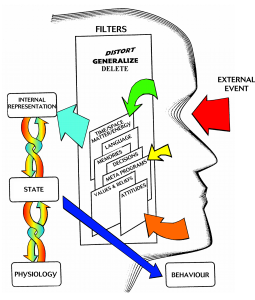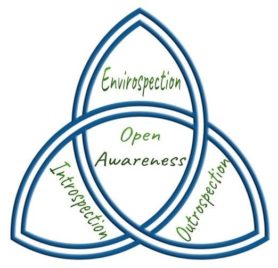The NLP Communication Model explains how we take information from the outside world into our neurology and how that in turn affects our thoughts, feelings and behaviours.
(Click here to watch the NLP Communication Model video)
 The NLP Communication Model, developed by Tad James & Wyatt Woodsmall (1988) from the work of Richard Bandler & John Grinder (1975), is one of the key structures in Neuro-Linguistic Programming (NLP) – though it draws heavily on concepts in Cognitive Psychology and the ground-breaking work of linguistic analysts Alfred Korzybski (1933) and Naom Chomsky (1964).
The NLP Communication Model, developed by Tad James & Wyatt Woodsmall (1988) from the work of Richard Bandler & John Grinder (1975), is one of the key structures in Neuro-Linguistic Programming (NLP) – though it draws heavily on concepts in Cognitive Psychology and the ground-breaking work of linguistic analysts Alfred Korzybski (1933) and Naom Chomsky (1964).
As human beings, we’re constantly taking in information through our five senses and processing it at an average rate of about 4 million bits of information per second. A vast majority of this information absorption and assimilation takes place unconsciously. Consciously trying to process all this information might be fun, but it certainly wouldn’t be sustainable or practical. Therefore, in order to discern and utilise relevant information, our nervous system filters it.
Our individual filters are determined by our perceptions of time, space, matter and energy, as well as the language we use, our understanding of words and gestures, our memories, the unique way we go about making decisions, the patterns we look for when selecting information, our values and beliefs, plus our overall attitude.
We then delete, distort and generalize information according to our unique filters (examples to follow). Once incoming information passes through our filters a thought is constructed. This ongoing process results in thoughts coming together to create internal representations (or maps of reality). Internal representations take the form of sensory perceptions: a picture with sounds, emotional feelings, tastes and smells. Our internal representations instantaneously trigger corresponding states, which in turn motivate all our behaviours.
The reality that we experience is largely determined by what we do inside our heads.
This means that everyone experiences any given situation differently. It’s our internal representations (subjective perceptions) that determine how we view the world and everything we experience. We unconsciously manipulate pure sensory information to create our subjective perceptions, based on the “programming” that has created our current set of filters.
Filtering is not a passive activity. We actively scan for evidence to confirm our existing world-views, thereby creating the self fulfilling prophecies that form the illusion of an objective experience of reality.
Our programming is determined by the sum of our experiences throughout our growth and development as human beings. Fortunately (with the use of NLP) we have the authority to reprogram the mental states and behaviours that we’d like to update. For example, understanding how our physiology (body posture) affects our state and therefore how we communicate, provides the agility to change strategies in order to better understand people, as well as to be better understood.
Our thoughts, feelings and behaviours stem from our unique filters. These filters vary from deeply unconscious processes to more conscious processes, namely:
Meta Programs – These are our most unconscious filters, thought by some to be our ‘blueprint’, or filters that we are born with. Meta Programs underpin our personality types, which explain why people respond differently in similar situations.
Values – These are the things that are most important to us. Values are our next most unconscious filter and are based upon our experiences to date. Values determine what the individual considers to be right or wrong, good or bad. Values are context specific, therefore what’s important in one area of your life, may not be important in other areas.
Beliefs – These are what support our values. Beliefs are what we hold to be true, about ourselves, others and the world. Whether religious or not, we all have beliefs, and the quality of our beliefs significantly influences the quality of our life.
Attitudes – These are the values and belief systems that we have about specific things.
Memories – These are the past individual and collective experiences that influence our current perceptions. Our present behaviours are significantly influenced by our collections of past memories.
Decisions – These are the past decisions about who we are and what we are capable of. They affect the decisions that we are faced with in the present. Past decisions are what create our present values, beliefs and attitudes, therefore they influence how we respond to current situations.
Now that our filtering system has been introduced, let’s explore how these filters operate:
As humans we do at least one of three things with incoming sensory information that has been filtered. We delete, and/or distort, and/or generalise all sensory input. This is referred to as a Universal Modeling Process in NLP.
Deletion – With the extreme amount of information entering and being processed by our nervous systems, we’re forced to omit certain aspects of our current experience by selectively paying attention to other aspects of it. In other words, we focus on what is apparently most important at a specific moment in time and the rest is deleted from our conscious awareness.
Distortion – We misrepresent our reality through distorting our experience of pure sensory information. Being intimidated by certain people, frightened of a harmless situation, procrastinating, or misinterpreting what someone says, are examples of how people distort reality. The process of planning, imagining or visualising something also uses distortion as a way of constructing goals and compelling futures.
Generalisation – The process of learning and drawing conclusions so that information can be applied for the achievement of any task, requires generalising. For example, a toddler who learns how to open a door for the first time, quickly generalises their new ability so that all types of doors can be opened from then on. Similarly, a negative experience may generalise through a persons life and result in issues later on, i.e. being bitten once by a dog can result in a phobia of dogs.
How is knowing about the NLP Communication Model useful?
Knowing about the various factors which affect human communication enables us to communicate with greater flexibility, while understanding other points of view better. Therefore we’re able to relate to people easily and respond to them on their terms. This builds rapport and allows for successful outcomes in leadership, mediation and negotiation. It also facilitates empathy and compassion in human interactions.
On the personal side, knowledge about the NLP Communication Model along with the application of NLP approaches enables people to ‘run their own minds’. More fulfillment in life is achievable when we are less affected by external circumstances, through gaining control of our internal processes. This leads to mental freedom, empowered responses, and mindful interactions with others.
(Click here to watch the NLP Communication Model video)
Written by Jevon Dangeli – NLP Trainer & Coach
Discover the book: NLP For Wizardry – The User Manual For Your Mind
References:
Chomsky. N (1964).Current issues in linguistic theory, The Hague: Mouton.
James. T & Woodsmall. W (1998). Time Line Therapy and the Basis of Personality, Meta Pubns
Korzybski. A (1933/1995). Science and Sanity: An Introduction to Non-Aristotelian Systems and General Semantics, Inst of General Semantics
